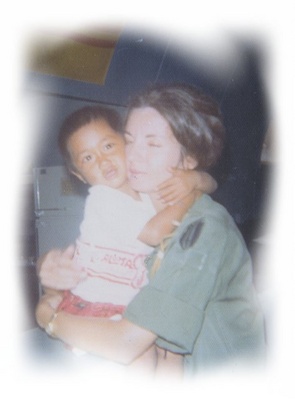 (Chester, PA) – Captain Maureen (Robbie) Robinson, Army Nurse Corps, was on her second tour in Vietnam in 1970 when she first saw Dinh Nit. According to the medical report, Dinh Nit was around three years old, weighted only 18 pounds, suffered from severe malnutrition, parasite infections, and protein deficiency.
(Chester, PA) – Captain Maureen (Robbie) Robinson, Army Nurse Corps, was on her second tour in Vietnam in 1970 when she first saw Dinh Nit. According to the medical report, Dinh Nit was around three years old, weighted only 18 pounds, suffered from severe malnutrition, parasite infections, and protein deficiency.
The ER was going to be her assignment, but the 27th Surg needed help in the civilian wards so Maureen worked with civilian casualties and ARVN soldiers. It was there that she first saw Dinh Nit.
Dinh Nit, a member of the Hre’ tribe, had been picked by an Army helicopter (Dustoff) in a morning or afternoon mission in the Tra Bong District and dropped off at the 27th Surgical Hospital (Mobile Army) in Chu Lai, 55 miles south of Da Nang.
It was not unusualpowerball for Montagnards family members to remain with their sick and injured family members while they recovered. Maureen said, “He had a young boy with him who said he was his brother and fifteen. He appeared to be no more than twelve. I remember he wore the tiger stripe fatigues common to PF [Popular Forces] and Montagnards attached to SF [Special Forces]. After a couple of days, he left and word was that he had to get back. I never saw him again."
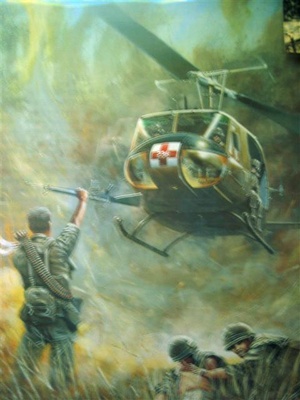 No question that the Dustoff crew saved the boy’s life. The Army’s radio call sign for medical evacuation choppers was “Dustoff.” The Army adopted the “Dustoff” call sign early in the Vietnam conflict. In 1962, the Navy Support Activity in Saigon controlled all radio call signs in South Vietnam. That year, the first Army helicopter evacuation unit to arrive in Vietnam was the 57th Medical Detachment. The 57th call sign was “Dustoff.” For Vietnam, it was a perfect match: Chopper pickups often blew dust, dirt, blankets, and shelter halves all over the ground. Dustoff stuck. From then on, Army medical evacuation choppers used the call sign “Dustoff” followed by a numerical designation. The only exception was the 1st Calvary Division who used the call sign “Medevac.”
No question that the Dustoff crew saved the boy’s life. The Army’s radio call sign for medical evacuation choppers was “Dustoff.” The Army adopted the “Dustoff” call sign early in the Vietnam conflict. In 1962, the Navy Support Activity in Saigon controlled all radio call signs in South Vietnam. That year, the first Army helicopter evacuation unit to arrive in Vietnam was the 57th Medical Detachment. The 57th call sign was “Dustoff.” For Vietnam, it was a perfect match: Chopper pickups often blew dust, dirt, blankets, and shelter halves all over the ground. Dustoff stuck. From then on, Army medical evacuation choppers used the call sign “Dustoff” followed by a numerical designation. The only exception was the 1st Calvary Division who used the call sign “Medevac.”
Maureen told me that: “The 236th Medical Detachment might have flown in this area. I have heard from members of the 54th and 68th groups, but no success. After all this time I know it is difficult to recall one mission, but thought I would try. Tra Bong was a difficult and dangerous place to fly in/out due to the mountain terrain, and the VC controlled the roads. I know we followed a dry riverbed to get there from Chu Lai. LZ Cindy and an SF Camp A-107 were located there. That was turned over to the ARVN Rangers around August/September 1970.”
The story of Dinh Nit’s recovery and Maureen’s struggle to adopt the young boy is compelling.
27th Surgical (27th Surg)
In May 1970 Maureen was assigned to the 27th Surgical Hospital (27th MASH) in Chu Lai.
The 27th Surg was in Vietnam from March 68 to June 71 and located at Chu Lai in the I Corps Tactical Zone (CTZ). It was under the 67th Medical Group and associated to the 23rd Infantry Division (Americal). The unit supplied resuscitative surgery and medical treatment to prepare for evacuation critically wounded or ill patients and was equipped to handle 135 bed patients. It was comprised of 27 officers, 40 ANC (Army Nurse Corps) and 95 enlisted men."
Working in the wards with civilian and ARVN, Maureen recalled that: “Our patients ranged from premature babies to geriatrics and we cared for the casualties of war–traumatic amputations, fractures, shrapnel wounds, burns and all the after effects of mines and weapons. We were also challenged by tropical diseases, too many to mention but malaria, blackwater fever, scrub typhus, dengue fever were a few. Then there were the assorted medical problems which included severe cases of malnutrition. A lot of our patients were children and there were times they were beyond our help.”
This was Maureen’s second tour as an Army nurse in Vietnam. Maureen said, “Iwas discharged in early 1968 and moved to DC to work at Walter Reed. I worked in orthopedics and the majority of my patients were wounded in Vietnam. I never forgot my time there and in late 1969 was ready to return. Initially, I was going to return as a civilian and interviewed with Catholic Charities and also considered a plastic surgery hospital in Saigon but then the Army came up with an offer I couldn’t refuse–a thirteen month tour for former army nurses who were VN vets. So by April 1970, I was on my way.”
Dinh Nit’s Health Improves
Kids are quick learners and Dinh Nit proved he was quick to learn in his new environment.
“During the weeks that followed, Dinh Nit thrived. He was putting on weight and his infections were responding to treatment. His prolapse ceased to be a problem. He was picking up English and Vietnamese and I was becoming more and more attached to this little guy. I can’t say the exact moment that I made my decision to adopt but I remember the day that I asked him if he wanted to be my son and go to America. He asked me if there were bunkers in America and when I said no –he looked very surprised and said–"What you do when VC come?". This was the world as he knew it–VC – war–he like so many others could not imagine any other life,” according to Maureen.
Montagnards—Forgotten Ally
Dinh Nit was a member of the Hre’ tribe, one of several tribes making up the Degar or Montagnards (mountain people in French). During the Vietnam War, the Montagnards were loyal allies of Americans. The location of the Montagnards in the Central Highlands placed them in a strategically important position since the Ho Chi Minh Trail, the North Vietnamese supply line, cut a path right through their backyard.
The U.S. Army’s Special Forces established base camps in the Central Highlands and recruited thousands of Montagnards to fight with them.
After the fall of Saigon, thousands of Montagnards fled to Cambodia, fearing reprisals from the North Vietnamese. Less than two thousand were resettled in South Carolina. Thousands remain in Cambodia today in refugee camps; an unknown number have been killed by the Vietnamese since the “official” end of the war in 1975. Thanks to efforts of Special Forces veterans, the largest community of Montagnards in the world is now located in Greensboro, North Carolina.
“Most Montagnards did not make it out of Viet Nam. The Cambodian camps are more recent and the last I heard around 400 are there. The Cambodian government was more or less "encouraged" to provide a refuge for those fleeing persecution because as a UN member, it’s expected. The Montagnards hid in the Cambodian jungle. Many died from starvation and disease. There were prices placed on the heads of Montagnards (by the Vietnamese government) who were captured by Cambodians–dead or alive. The conditions in these camps are horrendous. Although the UN is now involved, the abuses continue and unfortunately, our State Dept. has not been the refuge one would expect. The term forgotten ally says it all,” according to Maureen.
DEROS
Everyone serving in Vietnam, except general officers, knew before leaving the United States when he or she was scheduled to return. The tour in Vietnam lasted 12 months for everyone except the Marines who continued the Corps’ normal 13-month overseas tour. DEROS (date of expected return from oversees) promised the combatant a way out of the war other than as a physical or psychological casualty. For Maureen, she was fighting the DEROS clock to complete all paperwork to adopt Dinh Nit and obtain a Visa for her new son. She would need help to make it in time.
Maureen noted that, “Time was passing too quickly and I was due to DEROS in April ’71. I put in for an extension and began the one step forward and ten backwards that would be our story for the next nine months.”
“It is too involved to cover here but will relate a few incidents along the way. I met a Lt. Steve Thayer, Civil Service, who would be instrumental in helping us through the tough days that lay ahead. He arranged for our trips to Tra Bong and provided Sgt. Minh to interpret and helped me through the adoption process. Steve Thayer would be Nit’s godfather.”
“My DEROS date was nearing and no word was coming regarding approval. Whenever, Col. Fore, the Chief Nurse, would ask me about it–I just said the paperwork was due anytime. In reality, I didn’t have a clue but Plan A was to keep reporting for duty. There was no Plan B. On the day that was to be my DEROS date, I arrived on the unit and was told that Col. Fore wanted to see me. That was the longest walk that I ever took. I was trying to think of a plan that would permit me to stay and keep Nit from being placed in an orphanage. Col. Fore looked at me and said "Your extension came through this morning". I knew that we were on borrowed time. If things didn’t look promising–Nit would be discharged to an orphanage.”
“There was an increase in VC activity around this time and one night the Navy fired into the mountains that were just across from the 27th.For some reason, the 27th Surg was situated in front of Americal’s HQ and other units. Artillery hill was just across HWY 1 from us and the Aussies had turned it over to the ARVN. I was on duty that evening and remember when the first round hit. Somehow the 27th was not informed of the plan so we were all caught by surprise. The ground shook and everything seemed to be in double. We scrambled to get the patients that could be moved under the beds and cover the ones who couldn’t be moved with any protection we could find. Dinh Nit and Dinh Duong spent that night under the nurses’ station wearing our helmets. The VC managed a few rounds but no damage was done.”
Permission to Adopt
“We made several trips to Tra Bong to get permission from the District Chief to adopt. I remember flying in a chopper and following a dry river bed to the mountains and Tra Bong. There was a SF base camp and I can remember an airstrip of sorts 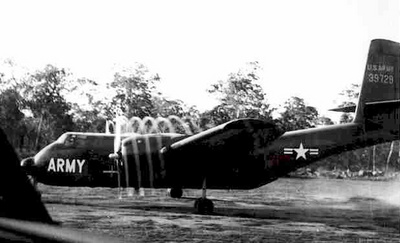 where Army CV-2 Caribous landed. There was a small waterfall coming down the side of a mountain and in the valley below were rice paddies. The district headquarters showed signs of a previous attack by the VC. There were large shell holes in the buildings. There were hamlets up in the mountain side and I also remember seeing Montagnard homes.”
where Army CV-2 Caribous landed. There was a small waterfall coming down the side of a mountain and in the valley below were rice paddies. The district headquarters showed signs of a previous attack by the VC. There were large shell holes in the buildings. There were hamlets up in the mountain side and I also remember seeing Montagnard homes.”
“I managed my visits in my off time and never really asked permission to go to the mountains–think I sensed what the answer would be so it was a case of no one asked and I didn’t tell. I was told that I would have to bring Dinh Nit to Tra Bong per order of the District Chief. I was hesitant for obvious reasons but felt there was no choice.”
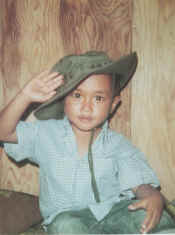 “On this trip, there was a long line of Montagnards waiting to see if Nit was the son, brother, nephew etc. that each was seeking. It was sad. One Montagnards arrived with his crossbow over his shoulder and wearing only a loincloth. He lifted Nit’s shirt to look for signs of a bullet wound. He was trying to find a nephew. He shook his head no and looked directly at me and nodded as if to say — take care of this child. Nit was very quiet during this whole period. He was not afraid but I think somewhat overwhelmed by the experience.”
“On this trip, there was a long line of Montagnards waiting to see if Nit was the son, brother, nephew etc. that each was seeking. It was sad. One Montagnards arrived with his crossbow over his shoulder and wearing only a loincloth. He lifted Nit’s shirt to look for signs of a bullet wound. He was trying to find a nephew. He shook his head no and looked directly at me and nodded as if to say — take care of this child. Nit was very quiet during this whole period. He was not afraid but I think somewhat overwhelmed by the experience.”
“On one trip, our flight was cancelled due to the weather and we had to spend the night. I managed to get a call through to Grace Squires to cover for me. Thankfully, my shift the next day didn’t start until 1900. They were expecting a "visit" from Charlie and we were told what to do if that happened. Artillery fired all night and every time a round went off –Nit would roll over and at one point he fell out of bed .He was the only casualty that night suffering a black eye. The next morning we were on our way. The chopper crew had to pick up and deliver ammo so we were dropped on a hilltop "somewhere" and picked up about a half hour later. There was a camp down a dirt road and a platoon was coming in from the bush. They looked so tired and beat–am not sure what they thought passing a young Montagnard boy and army nurse sitting on a hilltop just down from their base camp.”
“After many setbacks, I received permission to adopt. The next hurdle was to process the adoption and obtain a visa. Vietnamese law stated one had to be married and at least thirty. I was single and twenty-six. The orphanage in An Thon recommended Star of The Sea Orphanage in Da Nang. They handled adoptions for the US and Europe. I found an attorney who was affiliated with the orphanage and she agreed to help us. This was just the beginning.”
New Assignment
“The 27th was due to close and we all received new assignments. I got the 91st Evac about five miles away. At first, I was told that Nit would have to be placed in an orphanage until the adoption was finalized. I ‘pleaded’ my case and at the eleventh hour the Chief Nurse of the 91st agreed that he could come with me. I don’t think many thought that we would be successful. Again I was told if the adoption did not go through, Nit would be discharged to an orphanage. In May ’71, we moved.
“Our first night there, there was an alert and we spent some time in the bunker. Nit slept through it all. I was assigned to Ward 4 and continued to care for civilian and ARVN casualties. There was also a section for POW casualties. I would bring Nit to work and he would play with the kids there. When I worked the night shift (1900-0700), he slept on the ward and usually one of the nurses would keep an eye out for him so that I could get a few hours sleep.”
Extension and Adoption Approved
“I had put in for another three month extension. The ten steps backward routine was still going strong. Then one June morning, while on duty Steve called me. He asked me how it felt to be a mother. I was a little slow on the uptake but when it sunk in–I was ecstatic. Finally–thanks to help from so many individuals and a lot of prayers–Dinh Nit was officially my son. I named him Mark Stephen and his birth date was recorded as 8 November–the day he arrived at the 27th. He would keep his Montagnard name when confirmed at age 9. The visa would prove to be another hurdle and Steve Thayer was getting ready to DEROS"
Visa Hurdle
“While still at the 27th, Nit and I had to travel to Saigon about 400 miles south to apply for a visa at the American Embassy. I remember that one of the corpsmen stood in for me at the airport on standby so I could catch a few hours sleep after night duty. As we left the 27th, Col. Fore and the XO and other 27th staff stood and wished us luck. I had received a three day pass to cover the trip.”
“The XO (can’t recall his name but can see his face), gave me a number to call if we had problems returning. It would prove to be a lifesaver. We stayed at the Third Field Hospital in Saigon. I filled out the paperwork at the embassy and was told that a number is assigned and they could not tell me when he would be able to receive his visa. All numbers came by way of Manila. I contacted an attorney in Saigon but the Catholic orphanage that he worked with insisted that Nit would have to remain there. I wasn’t about to leave him 400 miles from where I was stationed.”
Hitchhiking Back to Chu Lai
“The push was on in Cambodia and all flights north were pretty much diverted. I placed a call to the number given to me and was given a list of courier flights that would in reality prove to be our hitchhiking our way back to Chu Lai. I could not tell you where in VN we traveled that day. We would board one chopper and then be dropped off in a clearing ‘somewhere" and another would arrive and pick us up. That was pretty much our day and Nit was a real trooper through it all.”
“Finally, I was notified that his number had arrived but I would have to travel to SaigonSaigon and volunteered to go to the embassy. Everything was starting to fall in place.”
Leaving Vietnam
“In late September, Nit and I were getting ready to leave. I had mixed feelings about leaving .So much had happened in the 17 months that I spent there and I knew that this would be a final farewell. It was hard to say goodbye to all the friends we made. Nit was almost 4 now and he knew we were going on a long trip but I also knew that he would be leaving a way of life and beginning a new one. It was a gigantic step for one so young.”
“We said our goodbyes and arrived in Cam Ranh Bay–problem was that Nit had to leave from Saigon. So the next morning at 0400, we were on another flight to Saigon. We spent a couple of days at Camp Alpha while I tried to get a flight to the US. One sergeant told me that there were no seats available for two weeks. After I said that we would sit on the floor of the plane–whatever it took–he told me not to worry and got us a spot on a flight the next day. When we were going through customs the Air Force sergeant commented-”Wow you just made it"–I realized that this was the last day for Nit’s visa to be valid. The Vietnamese guard was the last step before getting on the plane and he looked at Nit’s passport over and over–then at me–finally he waved us on and what once seemed to be impossible was coming true.”
“There is one short story I would like to relate. When Mark was about seven, I passed by his room and he asked me how to spell Montagnard. I asked him what he was writing and he was composing a letter to his mother in Viet Nam. This was around the time things were going from bad to worse there. This is what I remember–the original I saved and gave to Mark a couple of years ago:
Dear Mom,
I hope that you are well. I am fine. I have a new family now and am happy. I am sad that the VC are fighting the Montagnards. I hope that you are OK. We will win. We are Montagnards and a proud people.
Love,
Your Son,
Dinh Nit
“It was a very poignant letter and then he asked me to mail it. I didn’t know what to say but kept it and gave it to him years later. The Hre’ spirit lives on in my son and will be passed on to his children.”
Now married, Mark and Ling, his wife who was born in Thailand, have three children 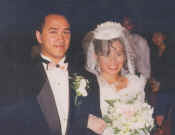 and own two restaurants in the Pittsburgh area. The Green Mango (Noodle Hut) in Edgewood and the latest one in the Penn Center East Mall.
and own two restaurants in the Pittsburgh area. The Green Mango (Noodle Hut) in Edgewood and the latest one in the Penn Center East Mall.
Maureen continues to look for the Dustoff crew that picked up Dinh Nit on November 8th. Any information about the Hre’, Tra Bong or surrounding areas or the Dust Off crew that picked-up Mark on November 8th can be emailed to Maureen Robinson at:
[email protected]. She know it’s a long shot and maybe the odds may even be better at winning the Powerball, but Army nurses don’t quit easily.

Robert O’Dowd served in the 1st, 3rd and 4th Marine Aircraft Wings during 52 months of active duty in the 1960s. While at MCAS El Toro for two years, O’Dowd worked and slept in a Radium 226 contaminated work space in Hangar 296 in MWSG-37, the most industrialized and contaminated acreage on the base.
Robert is a two time cancer survivor and disabled veteran. Robert graduated from Temple University in 1973 with a bachelor’s of business administration, majoring in accounting, and worked with a number of federal agencies, including the EPA Office of Inspector General and the Defense Logistics Agency.
After retiring from the Department of Defense, he teamed up with Tim King of Salem-News.com to write about the environmental contamination at two Marine Corps bases (MCAS El Toro and MCB Camp Lejeune), the use of El Toro to ship weapons to the Contras and cocaine into the US on CIA proprietary aircraft, and the murder of Marine Colonel James E. Sabow and others who were a threat to blow the whistle on the illegal narcotrafficking activity. O’Dowd and King co-authored BETRAYAL: Toxic Exposure of U.S. Marines, Murder and Government Cover-Up. The book is available as a soft cover copy and eBook from Amazon.com. See: http://www.amazon.com/Betrayal-Exposure-Marines-Government-Cover-Up/dp/1502340003.
ATTENTION READERS
We See The World From All Sides and Want YOU To Be Fully InformedIn fact, intentional disinformation is a disgraceful scourge in media today. So to assuage any possible errant incorrect information posted herein, we strongly encourage you to seek corroboration from other non-VT sources before forming an educated opinion.
About VT - Policies & Disclosures - Comment Policy



